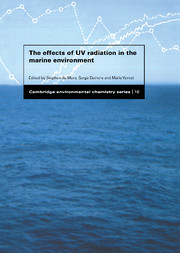Book contents
- Frontmatter
- Contents
- Contributors
- Preface
- 1 Enhanced UV radiation – a new problem for the marine environment
- 2 UV physics and optics
- 3 Spectral weighting functions for quantifying effects of UV radiation in marine ecosystems
- 4 Marine photochemistry and its impact on carbon cycling
- 5 Photochemical production of biological substrates
- 6 Mechanisms of UV damage to aquatic organisms
- 7 Strategies for the minimisation of UV-induced damage
- 8 UV radiation effects on heterotrophic bacterioplankton and viruses in marine ecosystems
- 9 Effects of UV radiation on the physiology and ecology of marine phytoplankton
- 10 Impact of solar UV radiation on zooplankton and fish
- 11 Implications of UV radiation for the food web structure and consequences on the carbon flow
- Index
10 - Impact of solar UV radiation on zooplankton and fish
Published online by Cambridge University Press: 20 August 2009
- Frontmatter
- Contents
- Contributors
- Preface
- 1 Enhanced UV radiation – a new problem for the marine environment
- 2 UV physics and optics
- 3 Spectral weighting functions for quantifying effects of UV radiation in marine ecosystems
- 4 Marine photochemistry and its impact on carbon cycling
- 5 Photochemical production of biological substrates
- 6 Mechanisms of UV damage to aquatic organisms
- 7 Strategies for the minimisation of UV-induced damage
- 8 UV radiation effects on heterotrophic bacterioplankton and viruses in marine ecosystems
- 9 Effects of UV radiation on the physiology and ecology of marine phytoplankton
- 10 Impact of solar UV radiation on zooplankton and fish
- 11 Implications of UV radiation for the food web structure and consequences on the carbon flow
- Index
Summary
Introduction
Solar UV radiation (UVR) has long been known to be damaging to many aquatic organisms. Reports of sunburn (erythema) in fish have been recognised for many years (Bell & Hoar, 1950; Eisler, 1961) and plankton ecologists have speculated that high UV irradiance could put severe restrictions on the distribution of sensitive species (Brehm, 1938; Thomasson, 1956). The discovery of the ‘ozone hole’ over Antarctica (Farman, Gardiner & Shanklin, 1985) provided the impetus for much of the recent research on the biological effects of UVR in aquatic environments, but ambient UVR is changing over temperate latitudes as well (Madronich, 1994; Orce & Helbling, 1997).
UVR has damaging effects on a variety of biological molecules and cell components that are common to most living organisms (Young, Moan & Nultsch, 1993; Williamson & Zagarese, 1994; Häder et al., 1995). In many cases, the results obtained with a particular group of organisms are general enough to be extended to other groups. In fact, much of what is now known about the effects of UVR at the molecular and cellular levels comes from studies with bacteria, algae and other unicellular organisms. Comparatively, very few studies have focused on zooplankton or fish. In contrast to the relatively similar effects among different groups of organisms at the cellular and subcellular levels, there are large differences at the levels of the organism, community and ecosystem that prevent straightforward generalisations.
This chapter reviews the effects of UVR on zooplankton and fish. Although this book is concerned mainly with the marine environment, examples are also included fromthe freshwater literature that complement the findings for marine species and may thus be useful to guide future research.
- Type
- Chapter
- Information
- The Effects of UV Radiation in the Marine Environment , pp. 279 - 309Publisher: Cambridge University PressPrint publication year: 2000
- 15
- Cited by



